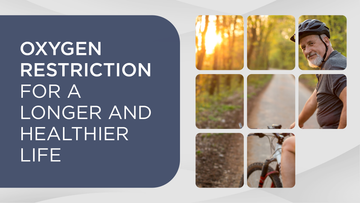
CO2 Therapy: What, Why, and How?
When we inhale, we take in oxygen, and on the following exhale we blow off the excess carbon dioxide produced in our body.
CO2 Therapy is about optimizing the levels of oxygen and carbon dioxide in your body. For most people, this means reducing the intake of oxygen and increasing the CO2 levels and tolerance for CO2.
This article focus on CO2, but you can read more here about the benefits of oxygen restriction for a longer and healthier life
Why should you do CO2 Therapy?
The main reason is that CO2 Therapy leads to more efficient oxygenation and energy production. Despite popular belief, that CO2 is just a simple waste product, optimum CO2 levels are vital for every bodily function.
Our body wants oxygen more than anything and carbon dioxide is heavily involved in all the steps of transporting the oxygen from the atmospheric air we inhale to the mitochondria in our cells.

To start with, carbon dioxide controls breathing. It is not lack of oxygen that makes us take the next breath, it is the build-up of excess CO2. Our brainstem is the center for survival functions like temperature, heartbeat, and breathing. Chemoreceptors in the brainstem check the levels of CO2 and when they reach a certain level, a signal is sent to our diaphragm to move downward, which starts the inhale. Low tolerance for CO2 translates to faster and bigger breaths, which is the hallmark of stress and anxiety.

Secondly, when we inhale, optimum levels of carbon dioxide ensures that the airways are kept open, by relaxing and widening the smooth muscle surrounding the airways, so that the air can flow easily in and out of the lungs.

Thirdly, when the oxygen we inhale has been transferred from the lungs over to the blood, optimum levels of carbon dioxide maintains open blood vessels, again by relaxing the smooth muscle that also surrounds the blood vessels, so that the blood can flow easily.

The next step is that once the oxygen-rich blood reaches the tissues where oxygen is needed, CO2 helps offload the oxygen from the blood so that it can enter the mitochondria of the cells and be of use.

And the final step is in the mitochondria, the powerhouses of our cells, where nutrients and oxygen are converted to energy. Oxygen is extremely reactive and if the energy production is not controlled, the mitochondria will be damaged and leak free radicals, which leads to oxidative stress and inflammation. Carbon dioxide protects the mitochondria from oxygen damage, which makes CO2 a powerful anti-oxidant.
So, as we can see, in all the five steps of body oxygenation, carbon dioxide is the main facilitator. It is CO2 that paves the way for oxygen so that we can produce energy efficiently.
In all health issues, lack of energy is a major problem. Either the process is inefficient, so we produce too little, or we consume too much, or both. Like a company with low sales and too high costs.
Lower levels of CO2 are common in today’s society because of over-breathing and inactivity, which leads to restriction, friction, and resistance. This means we have to spend more of our resources on survival, and we have less energy to recover, repair, enjoy life, and personal growth.
Low energy, a racing mind, anxiety, pain, sleep problems, airway problems, heart and circulation issues, overweight, poor athletic endurance are some of the problems closely related to lower levels of CO2, and where CO2 Therapy could be beneficial.
How do you do CO2 Therapy?
There are a number of ways to do CO2 Therapy. The easiest way is simply to just breathe slower, by closing your mouth and making the exhale slightly longer than the inhale. Slowing down our breathing reduces the outflow of CO2 when we exhale.
Other types of CO2 Therapy include:
Another form of CO2 Therapy is HIIT, High Intense Interval Training, as the intense training increases the CO2 levels to the point where the lungs can't manage to blow off all the excess CO2 produced.
ERB, Exercise with Restricted Breathing, for example nasal breathing, slow breathing, breath holds, and training mask is another way of doing CO2 Therapy.
And finally, BFR, Blood Flow Restriction training, or Kaatsu, is also CO2 Therapy. Restricting the blood flow to the working muscle prevents the CO2 from leaving the muscle. The response from the muscle to the higher CO2 levels is to grow bigger and stronger. Studies show that muscles that are exposed to CO2 mimic aerobic exercise, where the muscles grow bigger, the mitochondria increase in size and number, and more blood vessels are formed to support the muscle.







